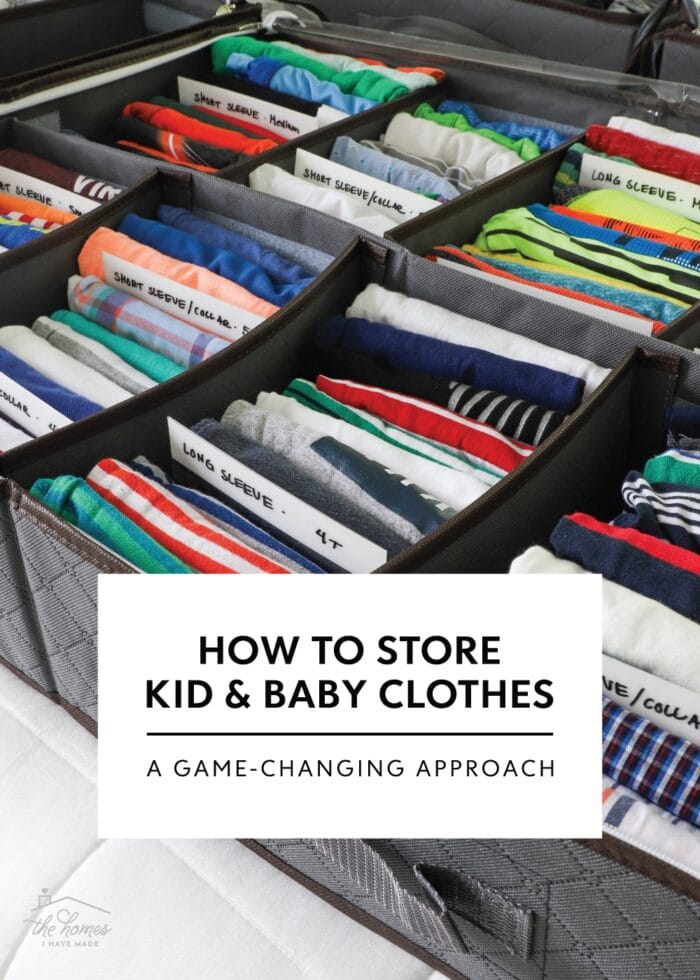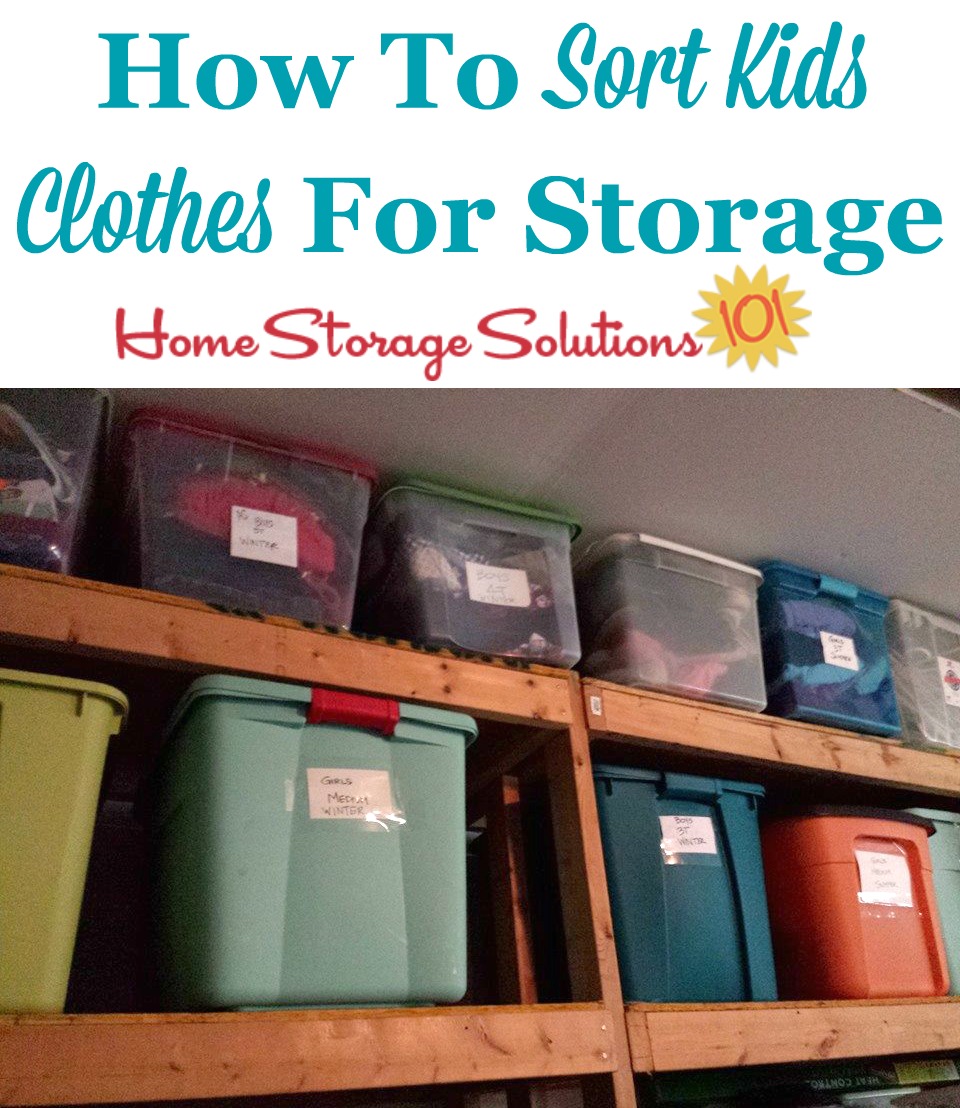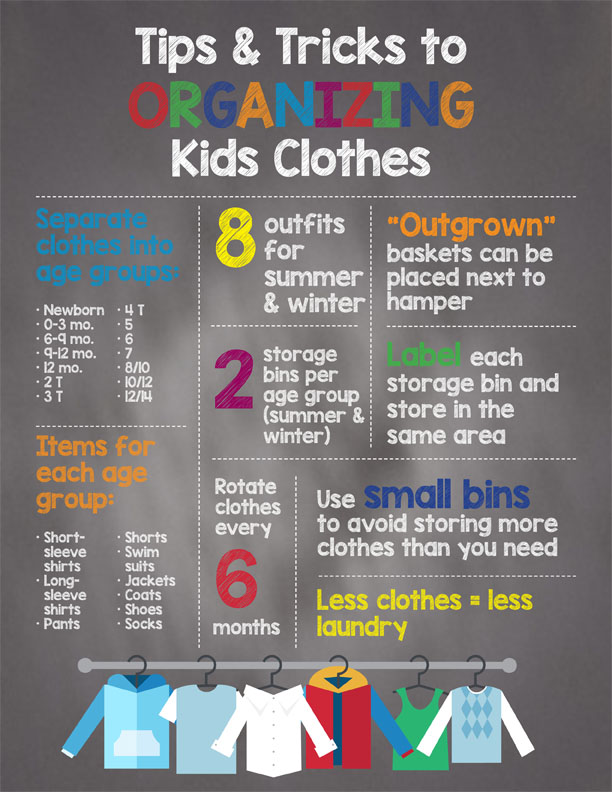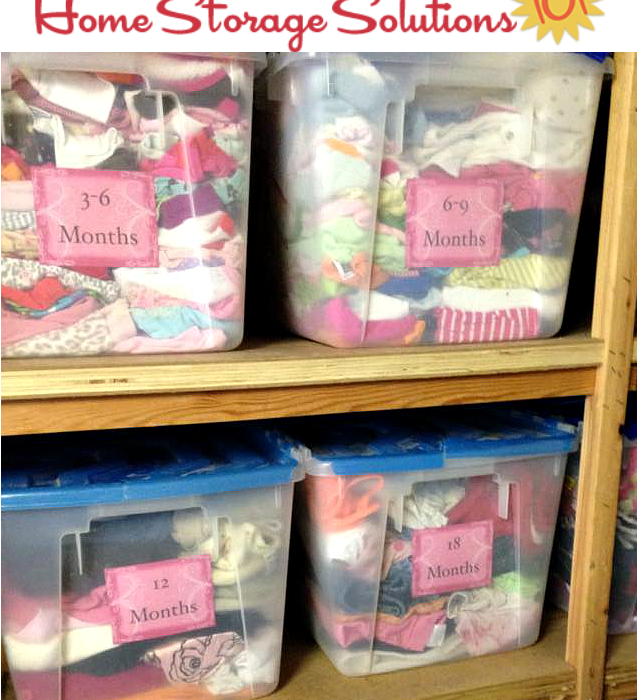Finding the best way to store kids’ clothes can be challenging. Kids grow quickly, and their clothes pile up fast.
Managing your child’s clothing is crucial for maintaining order in your home. You want to keep their clothes accessible yet organized. Whether you have a tiny closet or a spacious room, there’s always a solution. The trick is to find a method that suits your lifestyle and space.
In this blog post, we will explore practical and creative storage ideas. These tips will help you save space, time, and sanity. Ready to discover the best ways to store kids’ clothes? Let’s dive in!
Optimizing Closet Space
Optimizing closet space can make storing your kids’ clothes much easier. With a little creativity, you can maximize every inch of the closet. Let’s explore some effective strategies for making the most of your space.
Using Adjustable Shelves
Adjustable shelves are a great way to customize your closet. They allow you to change the height of each shelf to fit different items. This can be especially helpful for accommodating clothes of various sizes.
For example, you can create smaller spaces for folded shirts and larger spaces for bulky sweaters. Adjustable shelves also grow with your kids, making them a long-term solution.
To get started, measure the dimensions of your closet. Then, install shelf brackets that can be moved up and down. This gives you the flexibility to rearrange the shelves as needed.
Incorporating Hanging Organizers
Hanging organizers are another fantastic way to optimize closet space. They hang from the closet rod and provide multiple compartments for storage. These organizers are perfect for storing shoes, hats, and other accessories.
Consider using hanging organizers with clear pockets. This makes it easy to see what’s inside each compartment. You can also label each pocket for added organization.
Additionally, hanging organizers can be used to store outfits for the week. This helps streamline your morning routine and ensures your kids have everything they need.
To install a hanging organizer, simply hook it onto the closet rod. Make sure it’s securely fastened to avoid any accidents.
By using adjustable shelves and hanging organizers, you can make the most of your closet space. These simple solutions can help keep your kids’ clothes neat and accessible.

Credit: thehomesihavemade.com
Drawer Dividers
Keeping kids’ clothes organized can be a challenge. Drawer dividers are a simple yet effective solution. They help keep drawers tidy and make it easier to find items quickly. In this section, we will explore how to use drawer dividers to separate clothes by type and label them for better organization.
Separating Clothes By Type
Drawer dividers help you separate clothes by type. This makes it easy to find what you need. For example, you can use dividers to create sections for:
- Shirts
- Pants
- Underwear
- Socks
- Pajamas
By keeping each type of clothing in its own section, you save time. No more digging through piles of clothes. Everything has its own place. This also helps kids learn where their clothes go. It makes it easier for them to help with chores.
Labeling Dividers
Labeling dividers is an easy way to keep things organized. Use simple labels like “Shirts,” “Pants,” or “Socks.” You can use a label maker or write on sticky notes. Attach the labels to the front of each divider.
Here are some tips for labeling:
- Use clear, easy-to-read fonts.
- Choose labels in bright colors for visibility.
- Make sure the labels stick well to the dividers.
Labels help everyone know where things belong. Kids can easily put their clothes away. This keeps the drawers neat and tidy. Using labels also helps other family members. They can find and put away clothes without any confusion.
By separating clothes by type and labeling dividers, you create an organized system. This system saves time and reduces clutter. Drawer dividers make storing kids’ clothes simple and stress-free.
Under-bed Storage
Storing kids’ clothes efficiently can be a challenge. Under-bed storage offers a clever solution. It maximizes space and keeps things organized. This method is perfect for small rooms. Let’s explore some effective ways to use this space.
Utilizing Storage Bins
Storage bins are great for under-bed storage. Choose bins with lids to keep clothes dust-free. Transparent bins let you see contents at a glance. Label each bin for easy identification. Group items by type, such as shirts or pants. This method saves time and keeps clothes neat. Opt for bins with wheels for easy access.
Choosing Bed Risers
Bed risers create extra storage space. They are easy to install and come in various heights. Choose a height that suits your needs. Bed risers provide enough room for storage bins. Make sure they are sturdy to support the bed safely. Bed risers are an affordable way to increase storage. They help keep the room tidy and organized.
Rotating Seasonal Clothes
Rotating seasonal clothes is key to keeping kids’ wardrobes organized. Children outgrow clothes quickly, and seasons change. By rotating seasonal clothes, you ensure that kids always have the right clothes available. This method also saves space and keeps closets tidy.
Storing Off-season Items
Start by sorting clothes into summer and winter categories. Store off-season items in labeled bins. Place these bins in a cool, dry place. Avoid storing clothes in areas with high humidity. This prevents damage and mold.
Use vacuum-sealed bags for bulky items like coats. These bags save space and protect clothes. Keep shoes in separate boxes. Label each box clearly. This makes it easy to find items later.
Creating Seasonal Bins
Create a bin for each season. Use clear bins so you can see the contents. Label each bin with the season and size. This helps you stay organized. Rotate bins at the start of each season.
Donate clothes that no longer fit. This keeps the bins from getting too full. Store accessories like hats and gloves in smaller bins. Keep these bins within reach for easy access. This ensures that everything has a place.
Using Clear Bins
Storing kids’ clothes efficiently can be a challenge. One of the best methods is using clear bins. Clear bins offer multiple advantages and can make your life easier. Here’s why clear bins are a great choice for organizing your child’s wardrobe.
Easy Identification
Clear bins make it simple to see what’s inside. You don’t need to open each bin to find what you need. This saves time, especially during busy mornings. Plus, older kids can easily find their clothes, making them more independent.
Labeling the bins can add an extra layer of organization. Use labels like “shirts,” “pants,” or “socks.” You can even use pictures for younger kids who can’t read yet. This makes it even easier for them to find their clothes.
Stackable Solutions
Clear bins are often stackable. This feature helps you save space. You can stack bins in a closet or under a bed. This makes use of vertical space, freeing up room in your child’s bedroom.
Stackable bins are also great for seasonal clothes. Store winter clothes in the summer and vice versa. Simply stack them in a corner or on a shelf. This keeps the current season’s clothes easily accessible.
Here is a simple table to showcase the benefits:
| Benefit | Description |
|---|---|
| Visibility | See contents without opening |
| Space-saving | Stackable to utilize vertical space |
| Organization | Labels or pictures for easy finding |
| Seasonal storage | Store off-season clothes neatly |
Using clear bins for storing kids’ clothes is a smart choice. They help keep everything organized and easily accessible. Implementing this method can make daily routines smoother and more efficient.
Vacuum-sealed Bags
Storing kids’ clothes efficiently can be challenging. One of the best solutions is using vacuum-sealed bags. These bags offer a practical way to keep clothing organized and in great condition. Let’s explore how they help in maximizing space and protecting clothes.
Maximizing Space
Vacuum-sealed bags reduce the volume of clothes. They compress the fabric by removing air. This creates more room in closets and drawers. You can store more items in the same space. It’s ideal for seasonal clothing or hand-me-downs.
These bags fit easily into small spaces. Slide them under beds or stack them in closets. They are perfect for homes with limited storage. Space-saving is essential in busy households.
Protecting Clothes
Vacuum-sealed bags shield clothes from dust, moisture, and pests. They create an airtight seal. This helps keep fabrics fresh and clean. Clothes stay in good condition for longer periods.
These bags also prevent odors from setting in. The airtight seal keeps external smells away. Your child’s clothes will smell fresh even after long storage. This is especially useful for delicate fabrics.
Using vacuum-sealed bags ensures that clothes are ready to wear when needed. They are a reliable storage solution for any parent.
Hooks And Pegs
Storing kids’ clothes can be a challenge. An effective method is using hooks and pegs. This not only saves space but also teaches kids to stay organized. Hooks and pegs are versatile and can be placed almost anywhere. They make clothes easily accessible and keep them off the floor.
Hanging Accessories
Hooks and pegs are perfect for hanging accessories like hats, scarves, and belts. Install them at a height your child can reach. This encourages them to hang up their items themselves. You can use colorful hooks to make it fun. Label each hook for different accessories. This adds a layer of organization.
Creating Easy Access
Hooks and pegs create easy access to frequently used items. Hang them near the door or in the closet. This saves time during busy mornings. Kids can grab what they need quickly. It also helps in keeping their room tidy. Teach kids to put their clothes back on the hooks after use. This habit keeps their room clutter-free.
| Location | Items to Hang |
|---|---|
| Near Door | Coats, Backpacks |
| Inside Closet | Shirts, Dresses |
| Bathroom | Towels, Robes |
- Use hooks for hanging frequently worn clothes.
- Place pegs at child-friendly height.
- Label hooks for different items.
- Encourage kids to hang up clothes themselves.
Using hooks and pegs makes storing kids’ clothes easier and more fun. It keeps their space organized and accessible. This simple method can transform a messy room into a tidy one.
Over-the-door Organizers
Over-the-door organizers are a fantastic solution for storing kids’ clothes. They maximize space and keep everything within easy reach. These organizers can be used to store a variety of items, making them versatile and practical. Below, we explore two specific uses of over-the-door organizers.
Storing Shoes
Over-the-door organizers are excellent for storing kids’ shoes. They keep pairs together and make it easy to find the right shoes quickly. Each pocket can hold a single shoe, ensuring no more mismatched pairs. The shoes remain off the floor, keeping the room tidy.
| Advantages | Details |
|---|---|
| Saves Space | Utilizes unused door space |
| Easy Access | Kids can easily find and reach their shoes |
| Organized | Keeps shoes in pairs and off the floor |
Holding Small Items
These organizers are also perfect for holding small items. From socks to hair accessories, each pocket can store various small items. This keeps everything in one place, reducing clutter. Kids can find their belongings easily and quickly.
- Socks: Keep pairs together and easy to find.
- Hair Accessories: Store clips, bands, and brushes.
- Small Toys: Organize small action figures or dolls.
Over-the-door organizers are not just for shoes. They can hold any small item you need to store. This makes them a versatile choice for organizing kids’ clothes and accessories.
Labeling Everything
Keeping kids’ clothes organized can be a real challenge. One effective method is labeling everything. Labels help in sorting and finding clothes quickly. They make managing kids’ wardrobes easier and save time.
Using Color-coded Labels
Color-coded labels are very helpful. Assign different colors to each child. This way, everyone knows their color. Use bright colors for easy identification. Green for one child, blue for another.
Make sure the colors stand out. Use permanent markers or colored stickers. This method prevents mix-ups. It is simple yet effective.
Making Labels Kid-friendly
Labels should be fun and easy for kids. Use large, clear fonts. Add pictures or icons. For example, a shirt icon for shirt drawers. This helps younger kids understand.
Get kids involved in the labeling process. Let them choose icons and colors. This makes them feel included and helps them learn. They will be more likely to put clothes in the right places.

Credit: www.home-storage-solutions-101.com
Multi-functional Furniture
Multi-Functional Furniture is a game-changer for small spaces. It helps keep your child’s room tidy and organized. These pieces serve more than one purpose, making them perfect for storing kids’ clothes. Let’s explore some great options.
Choosing Storage Beds
Storage beds are a fantastic solution for kids’ rooms. These beds come with built-in drawers or shelves. They offer ample space for keeping clothes and other items. This design saves space and reduces clutter.
Here are some benefits of storage beds:
- Easy access to clothes
- Maximizes room space
- Reduces the need for extra furniture
Some popular types include:
| Type | Features |
|---|---|
| Captain’s Bed | Drawers underneath the bed |
| Loft Bed | Storage and play area below |
| Platform Bed | Multiple drawers and compartments |
Using Storage Benches
Storage benches are another excellent choice. They provide extra seating and storage space. These benches fit well at the foot of the bed or under a window. They can hold clothes, toys, or books.
Consider these advantages:
- Dual-purpose functionality
- Easy to use
- Variety of styles
Storage benches come in various designs:
- Bench with lift-top lid
- Bench with drawers
- Bench with baskets
Choose a style that suits your child’s room and your storage needs.
Rolling Carts
Rolling carts are a great way to store kids’ clothes. They provide mobile storage solutions and are easy to move around. Rolling carts help in keeping clothes organized and accessible. They come in various sizes and designs, making them a versatile choice for any room.
Mobile Storage
Mobile storage is a key advantage of rolling carts. They can be moved from room to room with ease. This flexibility allows you to store kids’ clothes wherever needed. You can easily wheel the cart into the laundry room for sorting. Or keep it in the bedroom for daily use.
Rolling carts often come with multiple tiers. This allows you to separate clothes by type or size. You can designate each tier for a different child or clothing category. The mobility and tiered design make organization simple and efficient.
Keeping Essentials Handy
Keeping essentials handy is another benefit of rolling carts. You can store daily wear, socks, and undergarments in easy-to-reach drawers. This setup makes mornings smoother and faster. Kids can easily access their clothes without much help. It encourages independence and makes dressing up fun.
Rolling carts also have side pockets or hooks. These are perfect for storing small accessories or shoes. Everything stays in one place, reducing clutter. With everything in reach, you save time and effort in finding clothes.
Donation And Recycling
Storing kids’ clothes can be challenging. They outgrow them quickly. Donating and recycling are great ways to manage this. You help others and reduce waste. This section will guide you on how to donate and recycle effectively.
Regular Purging
Regular purging is essential. Check your kids’ clothes every few months. Set aside clothes that no longer fit. This keeps their wardrobe manageable. It also ensures you have only what they need.
Make it a habit. Mark it on your calendar. Involve your kids. Teach them about sharing and recycling. It helps keep their room tidy.
Setting Up Donation Bins
Setting up donation bins is simple. Place a bin in your child’s room. Label it clearly. This makes it easy to drop in clothes that are too small. It also reminds them to contribute.
Use different bins for different types of clothing. For example:
- One bin for gently used clothes.
- One bin for worn-out clothes for recycling.
Donate regularly. Find local charities or shelters. Check their requirements. Some accept only clean, undamaged clothes. Others may take all types.
Recycling old clothes is also important. Find local textile recycling programs. Some stores have drop-off points. This reduces waste and supports the environment.
Here’s a simple table to keep track:
| Action | Frequency |
|---|---|
| Check clothes for purging | Every 3 months |
| Donate to charity | Monthly |
| Recycle worn-out clothes | As needed |
Organizing and maintaining donation bins is easy. It teaches kids valuable lessons. And you keep their wardrobe clutter-free.
Creating A Routine
Establishing a routine for storing kids’ clothes is essential. It helps in keeping their wardrobe organized. A consistent routine makes managing clothes easier and more efficient. This section will guide you on how to create a daily routine and involve your kids in the process.
Daily Organization Habits
Developing daily organization habits is crucial. Here are some simple steps:
- Sort Clothes Daily: Separate clean and dirty clothes every day.
- Use Laundry Baskets: Place baskets for sorting different types of clothes.
- Fold Immediately: Fold clothes as soon as they are dry.
- Assign Spaces: Designate specific areas for different clothing items.
These habits will help maintain a neat and tidy space. Consistency is key.
Involving Kids In The Process
Involving kids in organizing their clothes is beneficial. It teaches them responsibility. Here are some ways to get them involved:
- Make It Fun: Turn organization into a game. Use timers or rewards.
- Assign Tasks: Give them simple tasks like sorting socks or folding shirts.
- Use Labels: Label drawers and bins. Kids can easily find and store clothes.
- Teach and Guide: Show them how to fold and organize properly.
By involving kids, they learn valuable life skills. Plus, it makes the process quicker and more enjoyable.
| Task | Frequency | Responsibility |
|---|---|---|
| Sorting Clothes | Daily | Parent/Child |
| Folding Clothes | When Dry | Parent/Child |
| Organizing Drawers | Weekly | Parent/Child |

Credit: www.upliftingmayhem.com
Frequently Asked Questions
How Do You Organize Kids’ Clothes In A Small Space?
Use bins and labels. Roll clothes to save space. Store by size and season.
What Is The Best Way To Store Outgrown Kids’ Clothes?
Use vacuum-sealed bags. Label with size and season. Store in a dry, cool place.
How Can I Keep Kids’ Clothes Wrinkle-free In Storage?
Fold neatly and avoid overstuffing. Use tissue paper between layers. Store in a dry space.
What Are The Best Containers For Storing Kids’ Clothes?
Plastic bins with lids work well. They keep clothes dry and dust-free. Use clear bins to see contents.
Conclusion
Storing kids’ clothes can be simple and stress-free. Utilize clear bins and labels for easy access. Rotate seasonal clothing to save space and keep things fresh. Donate or sell items your child has outgrown. Implement these tips to maintain an organized closet.
Happy organizing!







